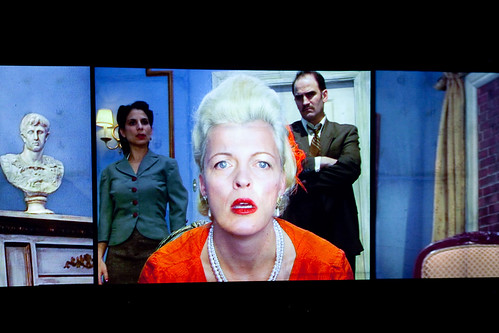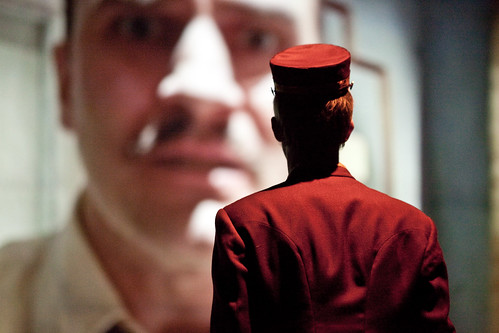Entrancing Exit at ACT
Hell truly is other people for Inez (Laara Sadiq, left), Estelle (Lucia Frangione, center) and Cradeau (Andy Thompson) in Jean-Paul Sartre's No Exit, a co-production of The Virtual Stage and Electric Company Theatre now at American Conservatory Theater. Below: The Valet (Jonathon Young) is condemned to watch Cradeau and his cellmates for eternity. Photos by Michael Julian Berz
I think I'd like Canada's The Virtual Stage and Electric Company Theatre to mount every play I never want to see again. I'm convinced they could make just about any inert script interesting and vital.
My interest in Jean-Paul Sartre's No Exit was minimal when I first read it in college and has only waned over the years. The play is a mostly stale pile of ideas with philosophies instead of plot and characters as metaphors rather than people. Is it possible we've simply outgrown existentialism? Historically, the play remains interesting – especially in view of the fact that Sartre's musing on the tortures of hell debuted in Paris in 1944 during the Nazi occupation.
Director Kim Collier (co-founder of Electric Company) is clearly aware that No Exit has some interesting ideas, but is in need of some major goosing.
Enter technology.
Andy Thompson, the founding artistic and managing director of The Virtual Stage, had just the technology to bring Collier's re-working of Sartre's play to life. The play's three main characters, who are locked together in a well-appointed chamber of hell for all eternity, really are locked away in what looks like a cement bunker (the set is by Jay Gower Taylor). But the bunker just happens to be outfitted with cameras, and the activity inside the bunker is broadcast live on three giant screens at the back of the stage.
This process has been called a live movie, and that seems appropriate. The choreography of the camera work is stunning and a welcome distraction from the play, which tends toward dullness about halfway through its brief 80-minute running time (this production uses Paul Bowles' 1946 translation).
Thompson, who created the show-defining video design, plays Cradeau, a lily-livered journalist who was executed by a firing squad. He enters first, and what an entrance! The side doors of the theater burst open accompanied by the ominous sound design by Brian Linds, and the visually arresting back lighting by Johnn Weber. The man comes stumbling into the theater and is directed on stage by the Valet (Jonathon Young). Clearly Cradeau is terrified. He's aware that he's dead and definitely not in anyone's idea of heaven.
When he sees the hotel room-like chamber that will be his eternal home, he expects thumbscrews or some such torture. But his particular form of torture will come in the form of his roommates: man-hating lesbian Inez (Laara Sadiq) and ultra-blonde Estelle (Lucia Frangione). All mirrors have been removed from the room (and not subtly, I might add) meaning these three will be each others' mirrors. They will not like what they see.
These are three horrible people who have killed babies, caused suicides and turned traitor. They deserve each other and the ridiculous sex/power games they're destined to play forever.
Aside from the live video aspect of the play, which would be interesting enough, Collier has given her production an extra layer of theatricality. While the nightmare triplets are locked in the bunker, the Valet has the stage to himself as he monitors the screens and deals with upper management (someone he calls "uncle"). Young is essentially inhabiting a play within a play: it's called The Valet and Young is credited as its author.
Forced to be an audience to the terrible trio, the Valet is in his own version of hell as we learn that what we're seeing is repeated endlessly and in exactly the same way (hey! It's just like a play!). Young interacts with images on the screen via a very tall ladder. He listens to records. And he sneakily communicates with the audience via notes soliciting our help to free him from this torture. His presence in the larger world of the stage lends some epic size to the chamber drama unfolding in the bunker.
This is the fifth time since 2008 that this play has been produced, and it's technically just about perfect (the night I saw it, one of the screens went briefly off-line, with those recognizable Windows warnings popping up then disappearing – an appropriate vision in hell). The actors are all fantastic and have really perfected the art of giving theatrical performances scaled to an unforgiving high-def camera (some of the cameras are actually low-tech spy cams). I couldn't get enough of Frangione's no-holds-barred Estelle, the character who actually offers some surprises (not the least of which are her fetching undergarments).
I must confess that I have an aversion to video in live theater and had great reservations about this production. But it's so astutely performed, so thoughtfully put together, that I enjoyed the weirdness of it immensely, which is really saying something given I don't have any affection for the play itself. You couldn't do this with just any play, but the marriage of multimedia and stagecraft provides salvation for No Exit. Who knew Jean-Paul Sartre could be so 21st-century hip?
[bonus interview]
I interviewed Kim Collier and Andy Thompson for the San Francisco Chronicle. Read the feature here.
FOR MORE INFORMATION
No Exit continues through May 1 at American Conservatory Theater, 415 Geary St., San Francisco. Tickets are $10-$95. Call 415-749-2228 or visit www.act-sf.org for information.

